Walt Disney once said that, “Disneyland will never be completed. It will continue to grow as long as there is imagination left in the world.” Those of us who have visited the park time and time again over the years know this statement to be true as we have seen the park constantly evolve and improve. With all the changes and transformations the park has endured throughout its more than five decades of existence, many attractions unfortunately have gone by the wayside.
However, not all originality is lost as there are still many attractions in the park today that were present on opening day – July 17th, 1955. Do you know which ones they are?
Disneyland originally opened with five themed lands – Main Street, U.S.A., Fantasyland, Adventureland, Fronteirland and Tomorrowland. Each of those lands contained at least one if not more rides (Disney calls them attractions). While some of the original attractions are no longer with us, 14 originals remain and continue to delight young and old alike to this day.
MAIN STREET U.S.A.
Disneyland Railroad – Originally called the Santa Fe & Disneyland Railroad, the Disneyland Railroad is a narrow gauge railroad that circles Disneyland park. This live steam railway was constructed at a cost of $240,000 and each of the original four locomotives cost in excess of $40,000.
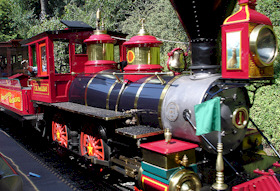 Riders can use the railroad as transportation to other areas of the park including New Orleans Square, Mickey’s Toon Town and Tomorowland or simply for the experience of the “Grand Circle Tour.” The Main Street railroad station is the first thing visitors see upon entering Disneyland.
Riders can use the railroad as transportation to other areas of the park including New Orleans Square, Mickey’s Toon Town and Tomorowland or simply for the experience of the “Grand Circle Tour.” The Main Street railroad station is the first thing visitors see upon entering Disneyland.
The railroad opened with two engines – the C.K. Holliday and the E.P. Ripley, both 4-4-0 steam powered locomotives that were built in the Walt Disney Studio in 1954. Today there are three additional engines – the Fred Gurley which was built by Baldwin Locomotive Works in 1894 and went into service at Disneyland March 28, 1958, the Ernest S. Marsh, a 2-4-0 originally built by Baldwin Locomotive Works as a 0-4-0 saddle-tank in 1925 which went into service at Disneyland July 25, 1959 and last but not least, the Ward Kimball, a 2-4-4 built by Baldwin Locomotive Works in 1902 for the Laurel Valley Plantation of Louisiana and later received in trade from Cedar Point Amusement Park as the inoperative Maud L in 1999. Restoration was begun by Boschan Boiler and Restorations of Carson in 2004 and the unit went into permanent service on June 25, 2005, as part of the park’s fiftieth anniversary celebration.
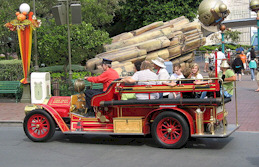 Fire Engine – While all the Main Street Vehicles may look like priceless antique means of transport, few of them have ever dated from the turn of the century. Robert Gurr designed the original vehicles in 1954 and 1955 using modern means and engineering, simply designing them to look like “the real thing”. The only genuine antique of the original Omnibus for example is its authentic Klaxon horn!
Fire Engine – While all the Main Street Vehicles may look like priceless antique means of transport, few of them have ever dated from the turn of the century. Robert Gurr designed the original vehicles in 1954 and 1955 using modern means and engineering, simply designing them to look like “the real thing”. The only genuine antique of the original Omnibus for example is its authentic Klaxon horn!
The original fire engine that debuted during opening day still picks up in Town Square and near Sleeping Beauty Castle in Central Plaza. Although not an authentic antique, it was modeled after fire engines actually used in the early 1900s.
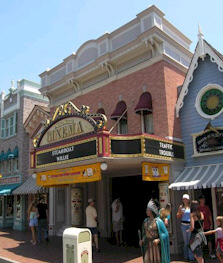 Main Street Cinema – The Main Street Cinema is a small movie theater located on Main Street, U.S.A. at Disneyland. The theater plays Disney shorts on six different screens while a recorded musical accompaniment plays. Five of the six shorts are played without sound; these shorts are changed from time to time. The third short is always Mickey Mouse’s 1928 debut cartoon “Steamboat Willie”, which is played with its original sound.
Main Street Cinema – The Main Street Cinema is a small movie theater located on Main Street, U.S.A. at Disneyland. The theater plays Disney shorts on six different screens while a recorded musical accompaniment plays. Five of the six shorts are played without sound; these shorts are changed from time to time. The third short is always Mickey Mouse’s 1928 debut cartoon “Steamboat Willie”, which is played with its original sound.
Unfortunately many guests pass right by this gem which can be found shortly after you enter the west entrance tunnel. I know that I did for years. It is however one of the few great places to escape the crowds that so often encompass the park. You may even find yourself enjoying some of the original cartoons that helped to make Disney what it is today.
ADVENTURELAND
Jungle Cruise – This attraction was in the opening day roster of the park and in fact was the only attraction available in Adventureland at that time. It has remained largely unchanged in theme and story since its debut.
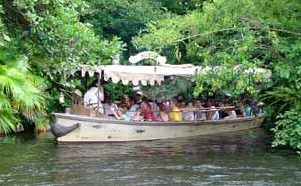 Aside from alterations and maintenance changes, four completely new show scenes have been added to date including the 1962 addition of Indian Elephant pool, the 1964 addition of African Veldt and Lost Safari scenes, and the 2005 addition of the Piranhas, and updates to Gorilla Camp scene (they throw bombs at the boats).
Aside from alterations and maintenance changes, four completely new show scenes have been added to date including the 1962 addition of Indian Elephant pool, the 1964 addition of African Veldt and Lost Safari scenes, and the 2005 addition of the Piranhas, and updates to Gorilla Camp scene (they throw bombs at the boats).
In 1995 the river channel was rerouted to make way for the queue buildings and entrance courtyard of the Indiana Jones Adventure. Also noteworthy is the 1997 replacement of the original ride vehicles.
Through its changes and many years of service, the Jungle Cruise continues to delight guests of all ages.
FRONTIERLAND
Mark Twain Riverboat – When Disney decided to include a Mississippi river boat in its theme park, it would be the first functional paddlewheeler to be built in the United States in fifty years. Because of this, WED designers conducted extensive research to build it very similar to the riverboats that were built in the heyday of steam powered ships.
 The decks were assembled at the Disney Studios at Burbank, while the 105-foot hull was constructed at Todd Shipyards in San Pedro, California (where the Sailing Ship Columbia’s hull was built years later). Fortunately, when the hull and decks were put together for the first time at Disneyland, they fit perfectly.
The decks were assembled at the Disney Studios at Burbank, while the 105-foot hull was constructed at Todd Shipyards in San Pedro, California (where the Sailing Ship Columbia’s hull was built years later). Fortunately, when the hull and decks were put together for the first time at Disneyland, they fit perfectly.
Joe Fowler, Disneyland’s construction supervisor and a former navy admiral, insisted on creating a drydock for the ship along what was to be the Rivers of America. Walt Disney, dismayed at how much land was taken up by the massive excavation, referred to the drydock first as “Joe’s Ditch” and then later “Fowler’s Harbor,” the name by which it goes by today.
The Mark Twain had its maiden voyage on July 13, 1955, four days before the park officially opened, for a private party celebrating Walt and Lillian Disney’s 30th wedding anniversary.
The Golden Horseshoe Stage (Golden Horseshoe Saloon) – The Golden Horseshoe Stage unofficially opened on Wednesday, July 13, 1955, as the Golden Horseshoe Saloon, when Walt and Lillian Disney, along with dozens of guests, celebrated their 30th anniversary with a private party and premiere showing of the original Golden Horseshoe Revue.
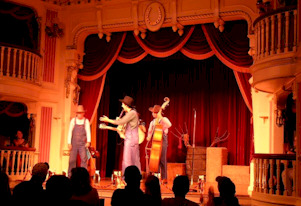 On Saturday, July 16, 1955, the Golden Horseshoe opened a day early for a private party of corporate sponsors. This show marked Wally Boag’s first official performance as Pecos Bill/Traveling Salesman at the Golden Horseshoe Saloon.
On Saturday, July 16, 1955, the Golden Horseshoe opened a day early for a private party of corporate sponsors. This show marked Wally Boag’s first official performance as Pecos Bill/Traveling Salesman at the Golden Horseshoe Saloon.
The first venue to open in the Stage was Slue Foot Sue’s Golden Horseshoe Revue (mistakenly spelled review when the correct word should have been “revue”) on July 17, 1955. This variety show ran a record 39,000 times and is listed in the Guinness Book of Records as the longest-running musical of all time. One of the features of the show was to have children from the audience, sing and dance on stage. “Davey Crockett,” was a favorite song performed by the guests.
Today, the Golden Horseshoe Stage is still popular inside and out and currently shows Billy Hill and the Hillbillies seven days a week. For years Disneyland served chili at the bar as well as drinks and deserts. Outside on the front balcony, there is a periodic, comedic wild west shoot-em’ up show performed by Laughing Stock and Company that always draws a crowd.
FANTASYLAND
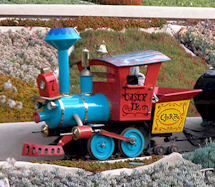 Casey Jr. Circus Train – While the Casey Jr. Circus Train was one of the original attractions of Disneyland, it almost did not debut on opening day. In fact, as the day drew closer, safety concerns were encountered. A test run over the new tracks led to the engine almost tipping over backwards as it attempted the 25-percent grade.
Casey Jr. Circus Train – While the Casey Jr. Circus Train was one of the original attractions of Disneyland, it almost did not debut on opening day. In fact, as the day drew closer, safety concerns were encountered. A test run over the new tracks led to the engine almost tipping over backwards as it attempted the 25-percent grade.
To counteract the issue, lead weights were added to the front and the train as able to run on opening day. However, the next day it was shut down and Casey Jr. did not run again until July 31 after work crews had leveled the grades and slowed down the ride.
King Arthur Carousel – This attraction was originally a Dentzel Menagerie Carousel that had been operated at Sunnyside Amusement Park in Toronto, Ontario since 1932. It was taken from there and moved to Disneyland in 1954.
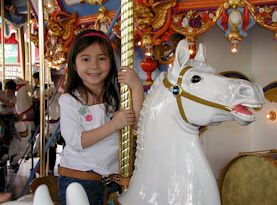 The carousel originally consisted of three rows of horses and animals on a 22 meter diameter platform but was refurbished and turned into a 4 row unit (thus increasing ride capacity) by adding additional horses that came from various other carousels from around North America.
The carousel originally consisted of three rows of horses and animals on a 22 meter diameter platform but was refurbished and turned into a 4 row unit (thus increasing ride capacity) by adding additional horses that came from various other carousels from around North America.
Since its debut at Disneyland, the carousel has been significantly altered. The original chariots were removed and are used as cars on the “Casey Jr. Circus Train” attraction. A Wurlitzer #157 band organ face is on the carousel, but does not operate. Motifs from Sleeping Beauty were used in 1955 to replace elements of the carousel. Also the Princess and the Jester Head motifs have been redone in 18k gold leaf.
Today the carousel has seventy-two horses, most which were originally carved in the Dentzel factory in the late 19th and early 20th century. Some of the horses were taken from a Stein and Goldstein carousel and Coney Island’s carousel in 1955 to add a fourth row, which I might add is completely made of jumpers and operated by custom-built crankshafts. Standers on the original three rows were converted to jumpers in 1955 as Walt wanted an “all jumper” carousel.
King Arthur Carousel reopened in February 2003 after extensive renovations. These renovations included an entirely rebuilt turntable and a new computerized operating system that stops the carousel in the same spot every time.
A couple of interesting facts – because of the overwhelming popularity of the carousel’s single white horse back in its early days, all horses have been painted white since 1975. Also, one of seventy-two horses is a mule.
Mad Tea Party – The Mad Tea Party is a spinning tea cup ride that not only debuted opening day at Disneyland but is featured at all five Disneyland-style theme parks around the world. The ride theme is from the Unbirthday Party scene of Disney’s animated film version of the story Alice In Wonderland.
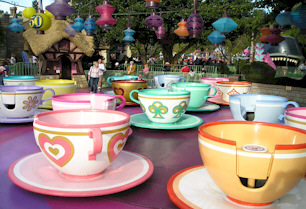 The Tea Cups have gained infamy over the years for the amount of guests who get motion sickness as a result of the spinning part of the ride. I’m one of them.
The Tea Cups have gained infamy over the years for the amount of guests who get motion sickness as a result of the spinning part of the ride. I’m one of them.
The Disneyland version was originally located directly behind Sleeping Beauty Castle (in the present-day location of King Arthur Carousel) and was moved to its present-day location in 1983.
Another interesting fact is that the original attraction at Disneyland is unable to run in the rain. Once the turntables are saturated with a moderate amount of water they slip and can no longer spin. All other versions of this attraction are covered to prevent such situations, as well as protect riders from extreme heat and sun.
Mr. Toad’s Wild Ride – Mr. Toad’s Wild Ride storyline is based on Disney’s adaptation of The Wind in the Willows, one of the two segments of the film The Adventures of Ichabod and Mr. Toad.
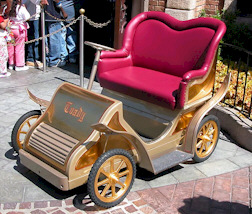 Guests board stolen old-fashioned multi-colored motorcars (mirroring the film’s story) with the names of characters (including Mr. Toad, Toady, Ratty, Moley, MacBadger, Cyril, Winky and Weasel) in the front of each motorcar and then begin their wild journey through Toad Hall, the countryside, a warehouse, the streets of London, a pub, and a town square before ending up in a courtroom where they are pronounced guilty.
Guests board stolen old-fashioned multi-colored motorcars (mirroring the film’s story) with the names of characters (including Mr. Toad, Toady, Ratty, Moley, MacBadger, Cyril, Winky and Weasel) in the front of each motorcar and then begin their wild journey through Toad Hall, the countryside, a warehouse, the streets of London, a pub, and a town square before ending up in a courtroom where they are pronounced guilty.
The cars then enter what is presumed to be dark prison cells before abruptly turning right and landing on railroad tracks. The vehicles bounce up and down on the tracks before colliding head-on with an oncoming train, where after they are sent to one of the ride’s most famous scenes — the ending scene in “Hell” (Disney style of course). The Hell scene is actually quite hot which provides an excellent effect. Guests are not in Hell too long and eventually escape back into the confines of Toad Hall and the real world.
A version of the ride used to exist at Walt Disney World in Florida but closed September 7, 1998 despite its popularity and many protests and was subsequently replaced with The Many Adventures of Winnie the Pooh.
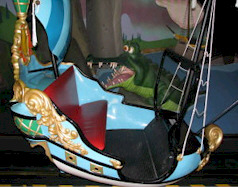 Peter Pan’s Flight – Peter Pan’s Flight is a single-bench suspended dark ride which is based on Walt Disney’s Peter Pan, the animated film version of the classic Peter Pan story by J.M.Barrie. The original intent of the attraction was for the guests to fly through the ride as if they were Peter Pan. Unfortunately audiences did not quite grasp this concept and were left wondering, “Why wasn’t Peter Pan in a Peter Pan ride?”
Peter Pan’s Flight – Peter Pan’s Flight is a single-bench suspended dark ride which is based on Walt Disney’s Peter Pan, the animated film version of the classic Peter Pan story by J.M.Barrie. The original intent of the attraction was for the guests to fly through the ride as if they were Peter Pan. Unfortunately audiences did not quite grasp this concept and were left wondering, “Why wasn’t Peter Pan in a Peter Pan ride?”
A Florida version of the ride opened in 1971, and while the overall theme and format of the ride was consistent with the original in California, this one would feature Peter Pan characters in Audio-Animatronic style.
In 1983, Fantasyland was completely revamped and in that revamping, Audio-Animatronic versions of the Peter Pan characters were added to the attraction, just like in Florida.
Snow White’s Scary Adventures (Snow White’s Adventures) – Snow White’s Scary Adventures originally opened as Snow White’s Adventures. Like the Peter Pan attraction where you are supposed to be Peter Pan, this ride experienced the same dilemma only in this case guests were Snow White. Few people understood this and wondered why Snow White wasn’t in a Snow White ride.
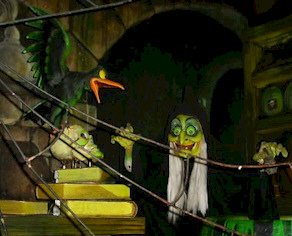 During the major 1983 overhaul to Fantasyland, Snow White was actually incorporated into the ride.
During the major 1983 overhaul to Fantasyland, Snow White was actually incorporated into the ride.
Some interesting facts regarding this attraction:
1. The ride vehicles are the Seven Dwarfs’ beds, each one named randomly after one of the dwarfs, just like in the film.
2. In the scene when the Witch offers the guests the poisoned apple, guests consistently tried (and often succeeded) to steal the apple. When Fantasyland was reopened in 1983, they solved the problem of the ever-missing poisoned apple by replacing it with a 3-D image of an apple. Guests who reach out to steal the apple now find their hands passing through it.
3. If you look in the window above the entrance to the attraction, you will see the queen open the curtains and peer out the window about every 30 seconds.
Storybook Land Canal Boats (Canal Boats of the World) – The original plan for this attraction was to be a “Lilliputianland”, inspired by Madurodam, a miniature city in the Netherlands that Disney once visited. However, the technology did not yet exist for creating the miniature animated figures that were to inhabit the “Lilliputian” village, so the canal ride opened under the name Canal Boats of the World. It was intended to be a journey past miniature recreations of the great landmarks of the world, but time and money prevented its completion by opening day.
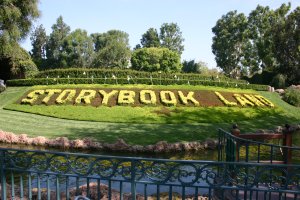 The ride was plagued with other problems. The outboard motors were prone to overheating, often forcing the boats to be pulled by hand, and because the attraction opened with little landscaping, it earned the nickname among park executives as “The Mud Bank Ride”.
The ride was plagued with other problems. The outboard motors were prone to overheating, often forcing the boats to be pulled by hand, and because the attraction opened with little landscaping, it earned the nickname among park executives as “The Mud Bank Ride”.
After only two months of operation, the Canal Boats closed on September 16, 1955 while Storybook Land was constructed and the muddy banks were landscaped with miniature plants, including a bonsai tree planted by Walt Disney himself. The idea of having Monstro the whale consume the canal boats came from a never-implemented concept for a “Monstro the Whale” ride, in which small boats were to be swallowed by Monstro and hurtled down a watery path into a pond below.
The attraction was re-opened on June 16, 1956 under the new name Storybook Land Canal Boats.
Over the years there have been many scenes added and removed from the attraction. Most notably, the Sultan’s Palace from Aladdin appeared where the miniature Toad Hall previously stood for a major refurbishment done in 1994. However, Toad Hall returned the following year in another location.
TOMORROWLAND
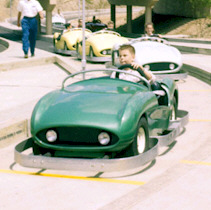 Autopia – This attraction was to represent the future of what would become America’s multilane limited-access highways, which were still being developed at the time of the park’s opening. It also provided young ones the experience of getting behind the wheel of a real gas-powered vehicle, although a small one.
Autopia – This attraction was to represent the future of what would become America’s multilane limited-access highways, which were still being developed at the time of the park’s opening. It also provided young ones the experience of getting behind the wheel of a real gas-powered vehicle, although a small one.
Prior to opening day, the cars were tested without the bumpers, and were almost completely destroyed by the test drivers. Bumpers were then fitted around the vehicle, but there were still problems with collisions, as a guide rail had yet to be implemented on the ride. Eventually the vehicles were fitted with spring-loaded bumpers to discourage collisions.
The Tomorrowland version received makeovers in 1967 and 1999. This version was not the only form of Autopia to exist at Disneyland over the years. Other versions included the Midget Autopia, Fantasyland Autopia (Rescue Rangers Raceway), and Junior Autopia. Of these, the Tomorrowland Autopia has existed the longest and remains today.

